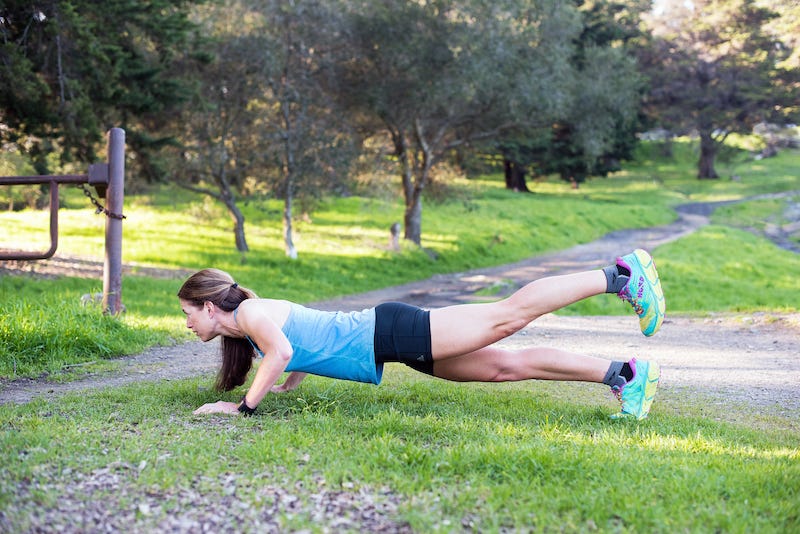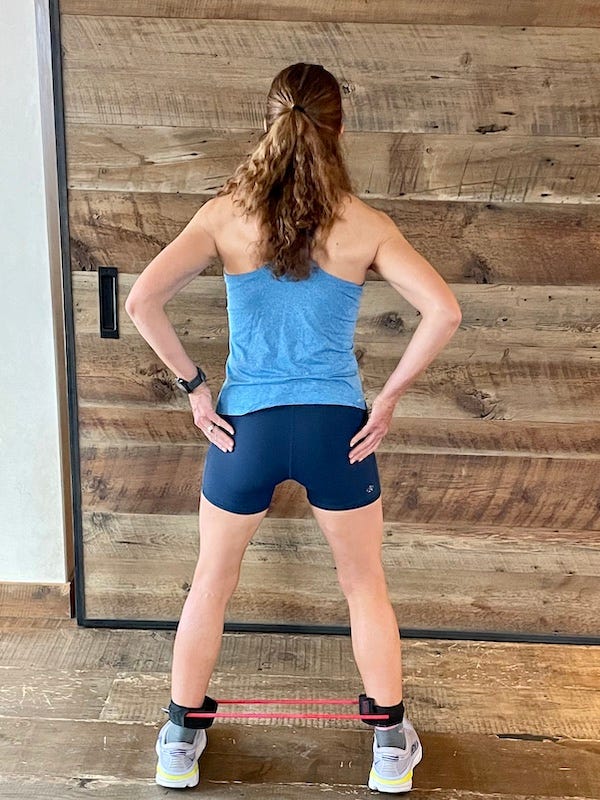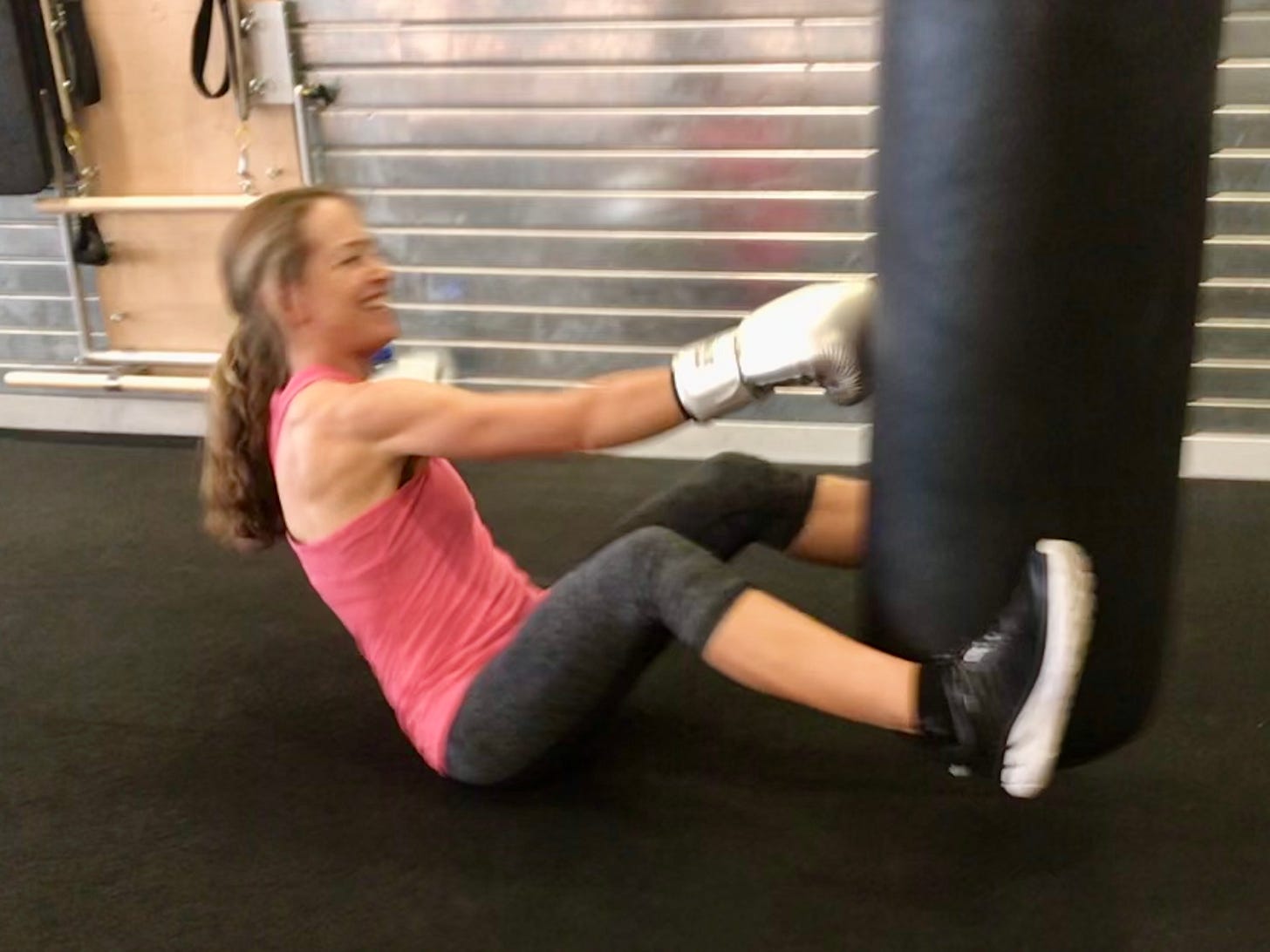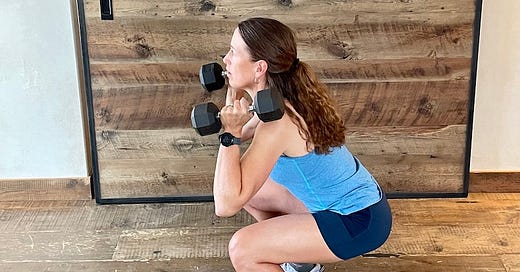Conditioning for Trail Runners: The Essentials
My take on how, when & why you should do strength & mobility exercises to complement running
The wind is howling, which I would mind less if it brought storm clouds our way. Recently, it’s been delivering blasts of warmer air from the south. I’ve been checking the weather apps obsessively, clinging to hope that the forecast calls for a few inches of snow to blanket the dull brown patches on the landscape, now drained of color. Fresh white would make it feel like winter again. Our driveway, and some of my favorite running routes, have turned into paths of treacherous ice due to a cycle of daytime melt and nighttime freeze.
Here around the San Juan Mountains, conditions this month have been pretty crappy for running and skiing, and this limbo between winter and spring put me in a funk.

I’m also in an in-between phase running-wise, because I have a road marathon in less than two weeks, so I’m tapering. While I value the early-season speedier and steadier marathon training for getting in better running shape, I want to get past it and back to training on trail for ultras this spring. I feel a pent-up restlessness, but I don’t enjoy being outside as much as usual because of the wind and ice.
Under these conditions, exercising indoors sometimes provides a welcome relief. Last Sunday, at home with minimal gym equipment, I did a fatiguing and satisfying all-over conditioning workout in only 35 minutes.
That workout inspired me to share coaching advice about conditioning, since many runners have questions about how much and what types of exercise other than running they should fit into their week. Some runners get hooked on Crossfit. Some swear by yoga. Some are multisport athletes who swim, cycle, or ski-mo. Some do nothing but run lots and lots of miles. Which approach is best, and what do you need?
The answer is, “It depends.” It depends on your training goals, where you’re at in your training cycle, and where you’re at in life in terms of age and fitness.
What I mean by “conditioning”
Conditioning is an umbrella term I use to include strengthening exercises that use extra weight or bodyweight for resistance; mobility exercises for range of motion, muscle control, and balance; and drills and plyometrics, which are specific exaggerated movements, often involving jumping, that foster better running skills and boost strength and cardio fitness. Physical therapy usually means a combo of customized strength and mobility exercises to correct specific weaknesses or asymmetry in your strength or movement.
Conditioning is different than cross-training, though a lot of people use the terms interchangeably. I use cross-training to refer to a different sport or recreational activity, such as cycling, swimming, or skiing. (Some people put yoga in the cross-training category, but I prefer to think of yoga as a form of mobility and light strength work, hence a type of conditioning.)
As a runner, you don’t need to cross-train, unless you want to for general health and happiness. Some of my clients, for example, want to devote one day of their weekend to golf or Nordic skiing, to which I say, OK, if it makes you a happier and more well-rounded person, let’s fit it in! But if they are training for a goal race, then in the eight weeks prior to that race I’ll recommend that they phase out their cross-training in favor of more specific running and rest.
Conditioning, by contrast, in my view always is worthwhile and belongs in every runner’s training, though the amount and type should vary depending on where they’re at in their training cycle.
Why you should do conditioning (and sometimes give it a rest)
Conditioning can lead to improved running, but usually not by a very significant margin. Strengthening muscles is one way (but not the only way) to improve “running economy,” which in simple terms means the amount of oxygen you use while running at a certain pace. If you have less running economy, you’ll need more effort to run.
Truth is, you can be a darn good runner without doing extra conditioning work. To become a better runner, you’ve gotta focus on running and recovery. So why take time for conditioning? I see three main reasons:
Injury prevention or injury recovery (aka pre-hab/rehab). Conditioning can help correct biomechanical flaws and weakness that contribute to injuries. It also can help you heal from an acute injury, such as a sprained ankle. For example, a PT might assign specific exercises to regain strength in your ankle area and to improve proprioception, thereby helping to prevent future sprains.
A stronger body makes for stronger trail running over mountains. Strong muscles in your legs, trunk, and arms will help you power up a hill and help you cope with the stress and impact of running downhill. It’s particularly valuable for flatlanders who want to train for a mountain race but lack steep hills to run.
Last but not least, the reason I personally prioritize conditioning: Because it helps counteract the loss of muscle mass that naturally happens as athletes—especially women—age. Our drop in hormones leads to a loss in skeletal muscle, but lifting weights can fight this loss. It also improves bone density. I know once-active female octogenarians now wheelchair-bound due to being weak and frail, having suffered falls and fractures, and I don’t want that to be me in 30 years!
Why not do it? Think of the tradeoffs. If you’re sleep deprived, then it’s better to spend an extra 30 to 60 minutes sleeping, not conditioning. If you’re barely able to get out the door to run three times a week, yet you want to develop as a runner, then make time to run an extra day or two a week instead of going to a gym to work out, if you only have time for one or the other.
Also, if you are at a point in your training cycle when volume and specificity matter most—for example, four to six weeks out from a high-altitude mountain ultra—then you’re better off increasing the amount of time you spend on terrain and in climate that mimics your race, and cut back your conditioning time in favor of more running and rest. Or, if you’re tapering and need to prioritize rest, then put your strength training on hold (though gentle mobility work continues to be beneficial during tapering).
A basic all-over workout
Normally, for myself and my clients, I split conditioning during the week into one or two workouts emphasizing lower-body work, and one or two emphasizing the upper body. We also work drills and plyos into their week. I’ll give some tips below for how to schedule conditioning.
Sometimes, you may want an all-over workout that combines all kinds of conditioning. This can be following a tough run, when you want to work on strengthening your lower body and also make the most out of a trip to the gym by conditioning your upper body too. Or, as was the case for me last Sunday, it can be a day when you feel like skipping a run because you lack motivation and/or the weather sucks.
This is what I did with some dumbbells, a jump rope, and a resistance band at home. It took about 35 minutes:
Dynamic stretches including leg swings and lunge variations, followed by 40 jumping jacks and a minute of jumping rope; repeat the jacks and jump rope. Why: I hadn’t run beforehand, so I needed to loosen up and warm up by raising my heart rate. The jumping jacks and jump rope, as plyometrics, are beneficial for cardio fitness, plus for developing agility, coordination, and power in the legs to navigate trail terrain.
8 inchworms = downward dog > walk hands out to plank > do a pushup > walk feet to hands and rag-doll fold > walk hands out to downward dog; repeat. Why: this is a mobility move that also has some core and arm strengthening. It promotes flexibility in areas where I’m stiff (Achilles, calves, hamstrings).
12 goblet squats with a 15 lb. weight. Why: Squat variations, especially those loaded with extra weight, target and improve many running-specific muscles.
10 pushups. Why: I love pushups for arm and core strengthening, and I like to challenge myself to do my age in pushups for a confidence as well as strength boost. I break up the 52 into manageable sets. I also sometimes add variations to them, such as holding a dumbbell and doing a row (lifting the weight to ribcage) and/or lifting a single leg and squeezing my glute.

Boat pose followed by supine plank, holding each to fatigue. Why: because both are difficult for me, so I need to work on them. Boat pose targets core. Supine plank targets my glutes and weak upper hamstring.
12 thrusters with a 12 lb. weight in each hand. Why: Same reason as the goblet squat variation above. Thrusters include an overhead press, thus also working arms and shoulders.
12 more pushups.
30 bicycle twists (15 each side). Why: this is a great exercise for abs & obliques that also gets the legs moving.
Side steps and backward steps with a resistance band (aka monster walks). I do at least 20 side steps each direction with slightly bent knees, then 20 or so stepping backward at a 45-degree angle, which fatigues the upper hamstrings and glutes. Why: Strong glutes and hamstrings are important for stronger and faster running, and also for stabilizing the pelvis and helping to prevent lower back and hip pain.

I like this type of resistance band that has cuffs to go around the ankle.
20 more pushups.
12 jump squats. Why: for the benefit of a squat, described above, plus the power-building and cardio boost of the jumping action.
30 reverse crunches. Why: to strengthen abs. This is just one of several types of crunch and plank variations worthwhile to do; take your pick.
10 - 12 each side of single-leg Romanian dead lift holding 10 lb. weights in each hand. Why: for work on balance (which also strengthens ankles and develops proprioception) and hamstrings. I have a history of high hamstring tendinopathy, and I find this exercise targets the upper hamstring in a challenging but beneficial way. It’s harder for me to perform this move on one side than the other, so I do a few extra on the side I need to improve.
Single-leg heel raise off the edge of the step, 20 each side. Why: to strengthen Achilles and calves, and prevent Achilles tendonitis.
10 pushups with side plank variation. After each pushup, rotate to side and briefly hold a side plank with one arm in the air. Why: this final set of pushups gets to my goal of 52, and adding in the side plank makes it more challenging and targets obliques.
20 bicep curls with 15 lbs. in each hand. Why: to further strengthen arms for a powerful arm swing and for non-running-specific strength. I am lacking heavier weights because I loaned my 20 and 25 lb. dumbbells to my son and haven’t had a chance to replace them. Ideally, I’d use weights heavy enough to make me feel fatigued with 12 - 15 reps.
12 lateral raises with 12 lb. dumbbells. Why: same as above, but targeting shoulders.
Repeat sets of bicep curls and lateral raises.
End with static stretching of all major muscles, especially glutes, hip flexors, IT Band. Why: to increase flexibility, since the workout creates tightness and fatigue. After stretching, approximately five minutes of foam rolling of all lower-body muscles and back. Why: to keep the fascia sliding and gliding over muscles as it should, and because it feels good.
Later in the day, I also made time for a 15-minute vinyasa yoga routine by a YouTube yogi I like and recommend, Yoga with Kassandra. Why: Her short but effective yoga routines loosen up stiff muscles and promote balance and flexibility, which for me translates to better form and flow when running. The yoga also relieves my often-achy lower back and makes me feel calmer mentally.
Not included in the workout above, because I didn’t have a bench: step-ups and step-downs. I’m a fan of step-ups and step-downs, especially while holding dumbbells or wearing a backpack with extra weight, for building strength for uphill running and, with step-downs, knee stabilization for downhills. I do them at the gym or at a bench outside.
I detailed my workout as just one example of some of the conditioning exercises I do to complement running and promote overall health and wellness. Another example of a good all-over workout with multifunctional exercises is this one by Jeff Browning aka Bronco Billy.
If you haven’t started any kind of conditioning, it’s a good idea to make an appointment with a personal trainer to learn which exercises are best for you, and how to do them properly.
If you’re unfamiliar with the names of any exercises above, google them, and you’re likely to find several helpful short video demos.
How and when to work conditioning into your week
Workouts can be short, 10 to 30 minutes, and still be effective. Scheduling gets complicated nonetheless. How should you layer in all these “extras” around your running?
I recommend approximately five minutes of drills (such as high-knees, butt-kickers, bounding, skipping, grapevines; check out Mario’s guide to drills for a good overview) as a warmup before a higher-intensity run, usually in the second mile. The first mile should be easy, the second mile can include drills and a set of strides, then start the speedwork. Why: Drills feature exaggerated motions that promote better running form, including a fuller stride and quicker cadence, and they build strength. Like pre-run dynamic stretching, they warm you up for the run workout to follow. They also challenge the body to move in different planes of motion with agility, which is useful for trail runners who have to navigate natural obstacles. Plus, they break up the monotony and stiffness that can develop while running on a flat, smooth surface.
I recommend plyometrics such as jump squats, box jumps, burpees, or jumping jacks as part of a lower-body strength workout following a hard run (more on this below). Plyos also are useful to do when you’re stopped at a red light and have to wait around mid-run. Why: Plyos complement lower-body strength training and boost cardio fitness. They develop power in the legs and lungs to improve uphill running.
Do one or two lower-body workouts throughout the week (one of these can be in the form of multifunctional exercises combined with upper body work). Do the most fatiguing lower-body strength work (including plyometrics) after your hardest weekday run. You can do it immediately following the run, but if you have time, I recommend refueling, rehydrating, and resting a bit before starting the strength workout. Why: Pair your lower-body strength work with your hardest run to make your hard day hard, and keep your easy-run or rest days oriented toward recovery. Do it after your high-intensity run so you don’t sabotage the quality of the run workout. Also, schedule this hard-day workout several days away from your depleting weekend long run.
Do two or three upper-body workouts during the week, prioritizing core, in combination with easy-run days. Why: a strong, engaged core is essential for stabilizing your torso and spine, providing support for your running. Strong arms can improve running form, endurance, and overall health. You can do upper-body conditioning on a day when you’re recovering from a hard run because it shouldn’t tax your lower body.
Do mobility work before a run to warm up; in combination with a strength workout; and/or later in the day following a depleting run. Why: mobility exercises loosen you up for running (which can prevent muscle strains caused by suddenly starting to run when stiff), promote balance/coordination and symmetry of form, and complement strength training and post-run recovery. They often play a role in physical therapy too.
Generally speaking, do more conditioning with heavier weights early in your training block, when you’re building a foundation for a good season of strong, fast running; ease up on the strength work as your running becomes higher volume and more specific later in the season. And generally speaking, if you’re experiencing localized or one-sided discomfort when you run, you probably need exercises advised by a physical therapist to help correct it.
Where should you start?
If the info above feels overwhelming, keep it simple and pick one thing that feels motivating and do-able. For me, when I was less fit, I began by trying to hold a forearm plank post-run for a minute. That’s all, one minute! Then I added a set of pushups. Then lunge variations. Then squat variations, etcetera.
Eventually, I took a boot-camp type of class at a gym with high-intensity interval training (HIIT). This introduced me to more types of conditioning, and the instructor helped me learn the exercises properly. I wouldn’t recommend a gym class like that for time-crunched runners, since working out in smaller time chunks pre- or post-run usually is more time efficient. However, a gym class can be fun, informative, and motivating.

Remember, even if you join a class, strive to keep your conditioning individualized, and do what’s right for you and your training goals.
In other words, beware of jumping into Crossfit and doing the non-individualized WOD with weights, trying to keep up with others, because you could get hurt or feel so sore afterward that you can’t run for days. Get the instruction you need from a trainer or physical therapist. If you can’t afford the time or money to work with a trainer or PT, try an app such as Recover that demonstrates exercises well and customizes workouts depending on the weakness or soreness you need to address.
For a smart overview of strength training, I recommend the chapter devoted to it in Jason Koop’s Second Edition of Training Essentials for Ultrarunning.
New race alert
This post is much longer than my usual posts, because of the complexity of the topic, but I want to add one more thing. If you read my post about Aravaipa Colorado, you might recall my prediction they’d add an event in the Durango area. Turns out I was right. Aravaipa just announced the inaugural Durango Skyline 30K/50K/50M for June 4. It’s tempting!
Related posts
I hope you’ll subscribe if you haven’t already, and consider subscribing at the supporter level for bonus content and access to a monthly online meetup. Last Sunday, our monthly Zoom featured a fantastic Q&A with elite-level runner and coach Brittany Charboneau. A recap of that meetup, with her takeaways of advice, is available for new paid subscribers.
What’s your conditioning routine, if you have one? Share your feedback in the comments below.





Do you have any tips for reoccurring shin splints? I used to NEVER get them but they've plagued me on and off for the last couple of summers. Talk about annooooying.
My recommendation although you should get coached through the first few and you need heavier kettlebells or dumbbells (heavier MAKES you have good technique so you can’t cheat your way through them): Turkish getups.
I recall Rob Krar said if he could only do one thing it would be getups. They’re complex, but fantastic all around core strength in a single exercise.